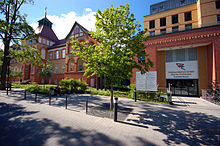Werner Forßmann Hospital
The Barnim Werner-Forßmann Hospital is a hospital with 16 main departments in Eberswalde . It is named after Werner Forßmann (1904–1979), who worked as an assistant doctor in the surgical department of the house in 1929 and received the Nobel Prize in Physiology or Medicine in 1956 .
history
The hospital was founded in 1895 as Auguste-Viktoria-Heim by the Patriotic Women's Association of the Province of Brandenburg . In 1927 the hospital was expanded to include a maternity hospital, a hospital for children and babies, and departments for internal medicine. In 1938 the mother house was closed and the clinic was now called Kurmark Hospital . It reopened in 1946. In 1952, as part of the administrative reform, polyclinics were added to the district hospital and in 1958 a branch in the former Lanke Castle . Sanitary facilities, stations of the community nurse, health rooms, aid and advice centers as well as medical and dental practices were added in the following years.
In the course of reunification in 1989/1990 , the polyclinic areas were partially dissolved again. In 1990 the Eberswalde hospital was converted into a GmbH and was given its current name. In 1991 further clinics were added: a neurosurgery , a urology , an eye and an ENT clinic. In 1997, the newly built radiation therapy clinic started work. In 2006, the Barnim and Uckermark districts together with the city of Eberswalde founded the Society for Life and Health GLG GmbH, which since then has operated three other hospitals in Eberswalde, Angermünde and Prenzlau and other health facilities in addition to the Werner Forßmann Hospital . In 2007, the merger made it possible to set up a stroke unit at the Martin Gropius Hospital on the premises of the Werner Forßmann Hospital.
The hospital has 460 beds.
The hospital is an academic teaching hospital of the Charité - Universitätsmedizin Berlin.
Clinics
- Medical Clinic I (gastroenterology, hematology, oncology)
- Medical Clinic II (nephrology, rheumatology, diabetology, dialysis)
- Medical Clinic III (cardiology, angiology, pulmonology, internal intensive care medicine)
- Medical Clinic IV (acute geriatrics, early rehabilitation, diabetology)
- Clinic for Pediatric and Adolescent Medicine
- Clinic for General, Visceral and Vascular Surgery
- Clinic for Trauma, Hand and Reconstructive Surgery
- Neurosurgical Clinic
- Urological clinic
- Clinic for Gynecology
- Ear, Nose and Throat Clinic
- Ophthalmology Clinic
- Radiotherapy Clinic
- Clinic for Clinic for Oral and Maxillofacial Surgery / Aesthetic and Plastic Operations
- Clinic for Anaesthesiology and Intensive Care Medicine
- Department of Radiology and Neuroradiology
Great personalities
August Hildebrandt (1868–1954), who founded spinal anesthesia together with August Bier (1861–1949) during his internship in Kiel in 1898 , was one of the company's chief physicians from 1913. Werner Forßmann (1904–1979) invented the cardiac catheter in 1929 as an assistant doctor in the surgical department of the house and received the 1956 Nobel Prize for Physiology or Medicine for it .
literature
- Ralf Bröer: The cardiac catheter self-experiment: Poetry and truth. Doctors newspaper, August 27, 2004 Online edition of this article
- Werner Forßmann: Self-experiment . Ecomed Verlag Landsberg, 2002. ISBN 978-3609160566
- Peter Oehme: Spinal Cord Anesthesia with Cocaine: The Priority Controversy on Lumbar Anesthesia. Deutsches Ärzteblatt 1998; 95 (41): A-2556 / B-2180 / C-1935. Online edition of this article
Web links
Coordinates: 52 ° 49 ′ 42.1 ″ N , 13 ° 47 ′ 24.6 ″ E



